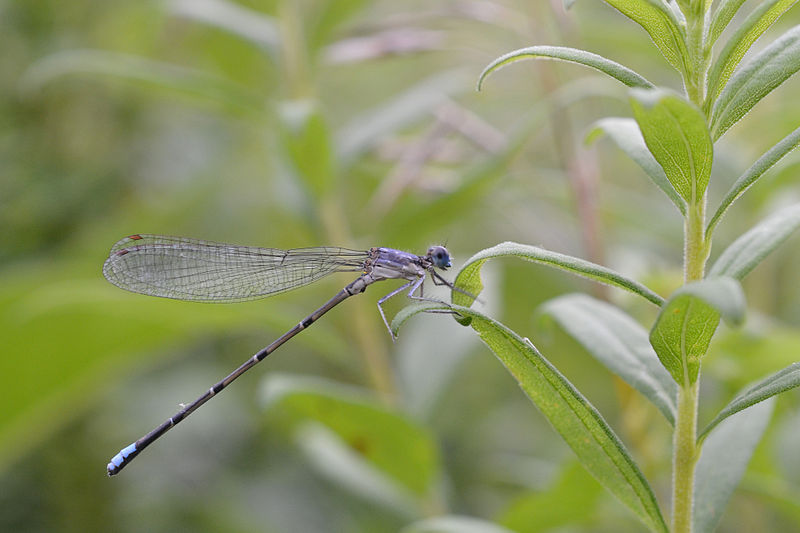
Damselflies belong to a group of insects that have very small antennae, very large eyes, two pairs of transparent wings, and colorful elongated bodies. There are over 2500 species of dragonfly worldwide and over one hundred thirty one in North America where they live near freshwater habitats such as streams, ponds, rivers, lakes, acid bogs, and marshes. Damselflies range in size from .3/4-1.3/4” long and with a wing span between .71-7.5”. Many are blue, red, yellow, green, brown or black, with the males more brightly colored than the females. The mouth parts are adapted for biting.
Damselflies resemble dragonflies and are closely related but can be distinguished in several ways. Adult damselflies have a fluttery flight while dragonflies are strong fliers. When at rest an adult damselflies folds their wings together over their bodies while the wings of dragonflies are out flat. The large eyes of a damselfly are on the sides of the head while those of a dragonfly are together at the top of the head. Damselfly larvae have longer and narrower bodies with fin-like gills at the end of the abdomen while dragonflies have shorter and thicker bodies with gills on the inside of the abdomen. The eggs of damselflies are cylindrical and twice the length of the round dragonflies eggs.
Both adult and larval forms of damselflies are predators. The adults feed on small crustaceans, fish, and other insects including mosquitoes, flies, termites, ants, mayflies and gnats. They are able to capture flying prey with their hairy hind legs and devour it as they fly. The larvae feed on water fleas (Daphnia) mosquito larvae, and other small aquatic larvae. They shoot out a flat, toothed mouthpart on their lower jaw to seize and pierce their prey.
Damselflies undergo incomplete metamorphosis . Adults emerge in spring, summer or fall and live a week to a couple of months carrying out most activities in the day time and resting in vegetation at night. The courtship behavior of some is elaborate and involves male and female flying in tandem in a heart or wheel position. The female lays eggs either in slits made with her ovipositor in water plants, or on the water. When the nymphs hatch they remain in or near the water and can be found on the aquatic vegetation or climbing on rocks and plants in slow moving water. They go through ten to fifteen molts before they emerge from the water, inflate their wings and abdomen, and become adults. They nymph stage lasts from a few months to several years depending on the species and environment.
Having a pond, creek, bog, stream or other wetland area is the key to success for attracting damselflies. If you are that lucky you can improve the habitat for damselflies by making sure that the water is not polluted and pesticide use is minimal. A diverse mixture of both wild and cultivated plant material is desirable.